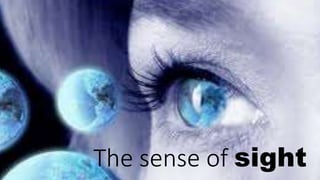The senses year 3
- 1. The sense of sight
- 2. Parts of the eye eyebrow eyelid pupil eyelashes iris
- 3. Eyebrows protect the eye from sweat and dust.
- 4. Eyelashes protect the eye from sweat and dust.
- 5. Eyelids protect the eye from sweat and dust.
- 6. Our eyes are the organs of sight.
- 7. We can see different shapes, sizes & colours.
- 8. The pupils are black but the iris can be different colours.
- 9. How the eye works
- 10. Light reflects off an object and enters the eye through the pupil. pupil
- 11. The light goes through the lens and make an image on the retina at the back of the eye. The image is upside down.
- 12. The retina sends the information to the brain.
- 13. The brain reads the signals and tells us what we can see.
- 14. Group 1 Group 2 Group 3 Group 4 Group 5 Total Brown Green Black Blue How many children have âĶâĶâĶâĶ. eyes?
- 16. The ears are the organs we use to hear
- 17. We can hear with our ears
- 18. We use our sense of hearing to hear loud sounds and quiet sounds https://www.youtube.com/watch?v=Rx7n7L6OnlA Loud sounds Quiet sounds
- 19. Parts of the ear
- 21. The earwax is a sticky substance inside our ear canal. It protects our ears from dirt and infection.
- 23. 1. Sound waves enter through the outer ear
- 24. 2. The waves hit the eardrum and make it vibrate
- 25. 3. The liquid in the inner ear moves and send informations to the brain 4. The brain reads the signals and tells us what we can hear. https://www.youtube.com/watch?v=SXhmXRbS6fw#t=31
- 26. 1. Ournose is the organ weuse tosmell. MY SENSES: SMELL. 2. Airenters the nose throughthe nostrils.
- 27. MY SENSES: SMELL. 3. The olfactory nerve sendsinformationto our brain. 4. Ourbrain tellsuswhat wecan smell. BRAIN
- 28. 5. Ourbrain classifies odours in good or bad smells. MY SENSES: SMELL. GOOD SMELL BAD SMELL Flowershave a goodsmell. Dirtysocks have a bad smell.
- 29. MY SENSES: SMELL. 6. We can smell about 10.000 different odours. ACTIVITY: HOW MANYDIFFERENT ODOURS CAN YOU SMELL? ACTIVITIES. http://faculty.washington.edu/chudler/chsmell.html ACTIVITY: MAKINGMODELS
- 30. The sense of taste
- 31. Our tongue is the organ we use to taste.
- 32. Our tongue is covered in taste buds. Taste buds identify different tastes.
- 33. Nerves send information to our brain.
- 34. We can identify four basic tastes: sweet, salty, bitter and sour.
- 35. The sense of touch
- 36. Our skin is the organ we use to touch. Our body is covered in skin.
- 37. Our skin can tell us if something feels soft or hard, hot or cold, rough or smooth.
- 38. Sensory nerves send information to our brain.





































